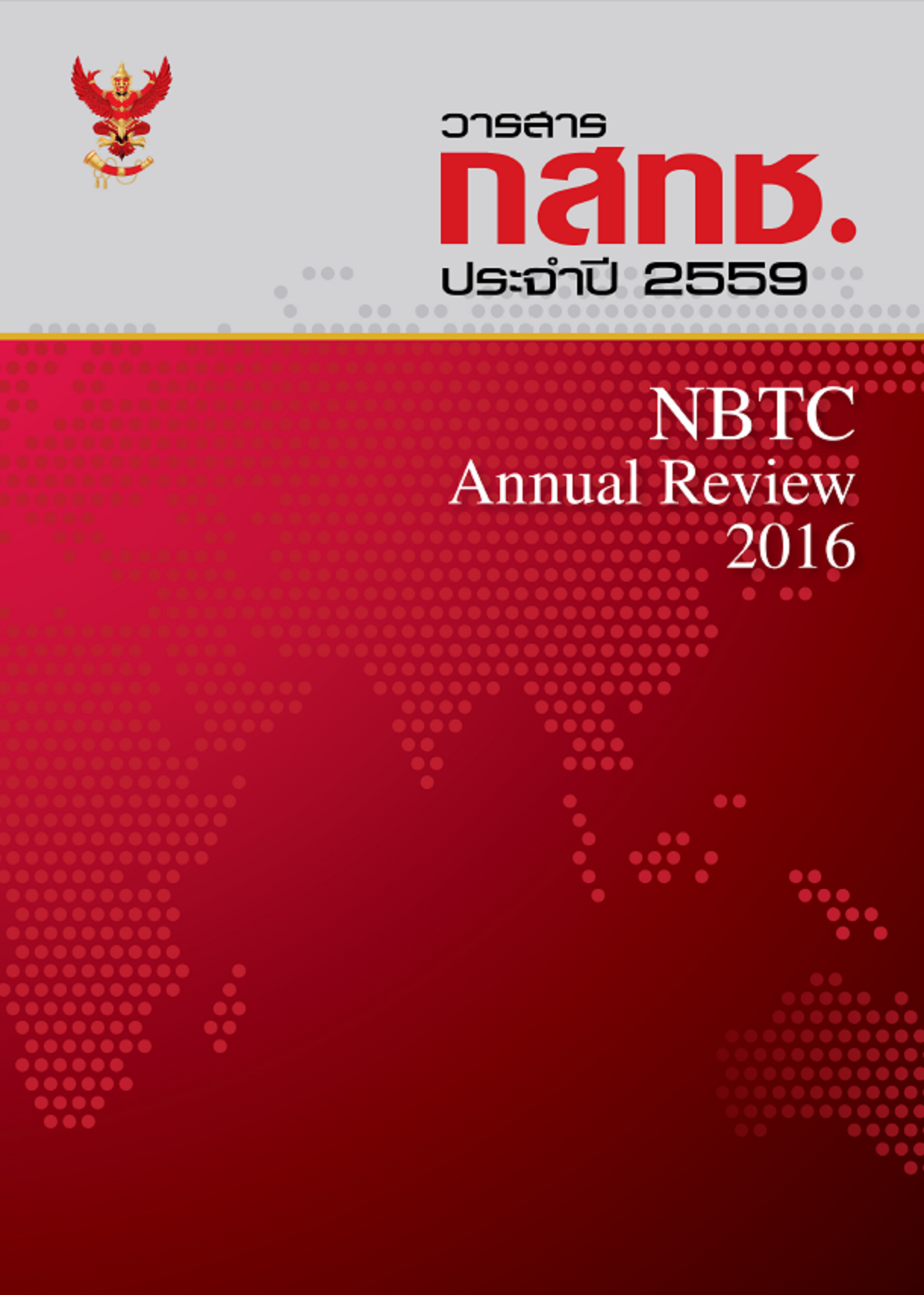Internet of Things and Regulatory Guidelines for Spectrum Management in Thailand
Keywords:
Internet of Things, IoT,, Spectrum Management, Short Range Devices, RegulationAbstract
This paper describes the Internet of Things (IoT) which has been embraced as a key factor to create massive disruptions in telecommunications, economy, and the ways people are living. The aim of the paper is to satisfy two major objectives. First, to present a review and necessary information on state-of-the-art IoT technologies, applications, and technical characteristics related to radio spectrum to the general public. Second, to provide the Office of the National Broadcasting and Telecommunications Commission (NBTC) the analytical data and recommendations for designing a spectrum management plan for IoT over the 5 and 10 year timeframes. A regulatory status which affects the adoption and development of IoT technologies in Thailand is discussed. The paper aims at supporting the Office of the NBTC to create a regulatory ecosystem and a policy direction that bolster the growth of IoT technologies while ensuring sufficient resources and maintaining spectrum efficiency. The key factors concerned in spectrum planning to avoid investment redundancies and connection incompatibilities are also highlighted in the paper.
References
กระทรวงพลังงาน (2558). แผนแม่บทการพัฒนา ระบบโครงข่ายสมาร์ทกริดของประเทศไทย พ.ศ. 2558-2579
สำนักงาน กสทช. (2006). ประกาศ กสทช. เรื่อง การใช้เครื่องวิทยุคมนาคมประเภท (Radio Frequency Identification: RFID)
พ.ศ. 2549
สำนักงาน กสทช. (2007). ประกาศ กสทช. เรื่อง เครื่องวิทยุคมนาคมและสถานีวิทยุคมนาคมที่ได้รับยกเว้นไม่ ต้องได้รับใบ
อนุญาต พ.ศ. 2550
สำนักงาน กสทช. (2007). ประกาศ กสทช. เรื่อง การใช้ความถี่วิทยุสำหรับอุปกรณ์สื่อสารระยะสั้น ย่าน ความถี่วิทยุ 5 GHz
พ.ศ. 2550
Andriod (2016). Retrieved from https://developer.android.com/guide/topics/sensors/sensors_overview.html
Angell, I., & Kietzmann, J. (2006). RFID and the end of cash? Communications of the ACM 49 (12): 90–96.
doi:10.1145/1183236.1183237. Retrieved 9 November 2013. ANT+ (2016). ANT+ device profiles Retrieved from
https://www.thisisant.com/ant/device-profiles
Bluetooth SIG Regulatory Committee (2011). Bluetooth Low Energy Regulatory Aspects
Cisco Systems (2013). Cisco Internet of Everything (IoE) Connections Counter
Cisco Systems (2014). Embracing the Internet of Everything to Capture Your Share of $14.4 Trillion
Cisco (2014). IoT World Forum. Retrieved from https://www.iotwf.com
Cisco (2014). White Paper on the Internet of Things Reference Model.
ECC (2013). Co-existence studies for proposed SRD and RFID applications in the frequency band 870-876 MHz
and 915-921 MHz
ETSI (2011). GSM
European Technology Platform for Smartgrids Forum (2016). Digital Energy 4.0
Forge, S. (2016). Radio spectrum for the internet of things, Vol. 18, pp.67 – 84 IEC, Orchestrating infrastructure
for sustainable Smart Cities
IEEE (2012). IEEE 802.11: Wireless LAN Medium Access Control (MAC) and Physical Layer (PHY) Specifications
IEEE IoT (2016). IEEE Internet of Things, Retrieved from https://iot.ieee.org
International Organization for Standardization (1994). ISO/IEC standard 7498-1:1994
IoT World Forum (2014). IoT World Forum Reference Model
ITU (2005). Cellular Standards for the Third Generation
ITU (2012). ITU-T Recommendation Y.2060
ITU (2012). Report ITU-R SM.2255-0 :Technical characteristics, standards, and frequency bands of operation for
radio-frequency identification (RFID) and potential harmonization opportunities
ITU (2015). ITU Radio Regulations, CHAPTER II – Frequencies, ARTICLE 5 Frequency allocations, Section IV –
Table of Frequency Allocations
ITU (2016). ITU-T SG20: IoT and its applications including smart cities and communities (SC&C),
https://www.itu.int/en/ITU-T/studygroups/2013-2016/20/
Kraus, B., Monika, K., & Xiong, S. (2015). Worldwide Internet of Things Spending by Vertical Market 2015–2018
LoRa Alliance (2015). LoRa Specification
Motorola (2010). "Long Term Evolution (LTE): A Technical Overview"
New J., & Castro, D, (2015). Why Countries Need National Strategies for the Internet of Things.
NFC Forum (2011). Technical Specifications. Retrieved from https://members.nfc-forum.org/specs/spec_list/
Ngonga, A. (2013). Data acquisition, University of Leipzig and AKSW Research Group, presented at Big Data
Webina 2013
Ofcom (2015). More Radio Spectrum for the Internet of Things.
Puccinelli, D., & Haenggi, M. (2005). Wireless sensor networks: applications and challenges of ubiquitous
sensing. Circuits and Systems Magazine, IEEE, 5(3), 19-31.
Radiocommunication Bureau (2015). Results of the first session of the Conference Preparatory Meeting for WRC-19
(CPM19-1).
Sigfox (2016). Sigfox Technical Specification. Retrieved from https://makers.sigfox.com
Terman, F. E., & Helliwell, R. (1955). Electronic Radio and Engineering, 4th ed., MacGraw-Hill, ISBN 978-0-07-
-7
Thread Group (2014). Thread following IEEE802.15.4
World Economic Forum (2015). Industrial Internet of Things: Unleashing the Potential of Connected Products and
Services
World Economic Forum (2015). The Future of Financial Services How disruptive innovations are reshaping the way
financial services are structured, provisioned and consumed
Zemede, M. (2015) Building IoT gateways to the cloud. Retrieved from https://www.microcontrollertips.com
/building-iot-gateways-to-the-cloud/
Zigbee Alliance (2012). Zigbee Specification
Z-Wave Alliance (2014). Z-Wave Transceivers – Specification of Spectrum Related Components
Downloads
Published
How to Cite
Issue
Section
License
The Office of the NBTC holds the copyright of articles appearing in the journal. The Office of the NBTC allows the public or individuals to distribute, copy, or republish the work under a Creative Commons license (CC), with attribution (BY), No Derivatives (ND) and NonCommercial (NC); unless written permission is received from the Office of the NBTC.
Text, tables, and figures that appear in articles accepted for publication in this journal are personal opinion and responsibility of the author, and not binding on the NBTC and the Office of the NBTC. In case of errors, each author is solely responsible for their own article, and not concerning the NBTC and the NBTC Office in any way.



